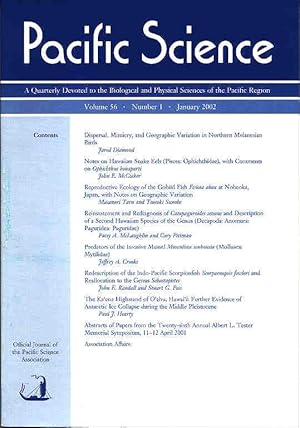Carr Gerald Eds Curtis Daehler (1 results)
Product Type
- All Product Types
- Books (1)
- Magazines & Periodicals
- Comics
- Sheet Music
- Art, Prints & Posters
- Photographs
- Maps
-
Manuscripts &
Paper Collectibles
Condition
- All Conditions
- New
- Used
Binding
- All Bindings
- Hardcover
- Softcover
Collectible Attributes
- First Edition
- Signed
- Dust Jacket
- Seller-Supplied Images
- Not Printed On Demand
Seller Location
Seller Rating
-
Pacific Science, vol. 56, no. 1 (January 2002) Dispersal, Mimicry, and Geographic Variation in Northern Melanesian Birds; Notes on Hawaiian Snake Eels (Pisces: Ophichthidae), with Comments on Ophichthus bonaparti; Reproductive Ecology of the Gobiid
Published by Honolulu, University Press of Hawai'i, 2002., 2002
Seller: Joseph Valles - Books, Stockbridge, GA, U.S.A.
Soft cover. Condition: As New. 104 pp. ; paper wrappers ; illustrated ; Contents: Dispersal, Mimicry, and Geographic Variation in Northern Melanesian Birds / Jared Diamond (Abstract: I present new information about 34 of the 195 resident land and freshwater bird species of north ern Melanesia, an area characterized by a rich avifauna, high endemism, and great geographic variation in morphology. There are many examples of geographic variation in voice, behavior, habitat preference, altitudinal range, vertical stratum, abunda nce, and nest. Possible vocal convergence or mimicry between sympatric populations of different species is described between the goshawk Accipiter albogularis and the kingfisher Halcyon chloris, between the cuckoo-shrike Coracina [tenuirostris] and other species in its mixed-species foraging flocks, between the white-eyes Zosterops murphyi and Z. rendovae kulambangrae, and between the starlings Aplonis grandis and Mino dumontii. Hybridization is reported between the Bismarck and New Guinea rac es of the cuckoo Eudynamys scolopacea on Long Island (described as a new subspecies), between the whistlers Pachycephala pectoralis and P. melanura, and between the honey-eaters Myzomela tristrami and M. cardinalis. Cyclones bring Australian species , some of which occasionally remain to breed. Over-water dispersal ability varies greatly, from species that can be seen flying over water any day to species that rarely or never cross water. For instance, a channel 12 km long and only 0.15-1 km wid e divides Florida Island into two halves, one of which possesses and the other of which lacks a resident population of the coucal Centropus milo) -- Notes on Hawaiian Snake Eels (Pisces: Ophichthidae), with Comments on Ophichthus bonaparti / John E. McCosker (Abstract: The 22 ophichthid eel species of the Hawaiian Islands (including Johnston and the Northwestern Hawaiian Islands) are reviewed, and a key to their identification is provided. New Hawaiian records of Indo-Pacific species include C allechelys catostoma and Ophichthus bonaparti. Callechelys lutea is reported from Johnston Island. Hawaiian and Johnston Island ophichthid species comprise: Apterichtus flavicaudus, Brachysomophis crocodilinus, B. henshawi, Callechelys catostoma, C. lutea, Cirrhimuraena playfairii, Ichthyapus vulturis, Leiuranus semicinctus, Muraenichthys schultzei, Myrichthys colubrinus, M. magnificus, Ophichthus bonaparti, O. erabo, O. kunaloa, O. polyophthalmus, Phaenomonas cooperae, Phyllophichthus xenodon tus, Schismorhynchus labialis, Schultzidia johnstonensis, Scolecenchelys cookei, S. gymnota, and S. puhioilo. Additional data are provided for the rare deep-water species Ophichthus kunaloa. The following synonymies are proposed: Ophisurus chrysospi los Bleeker, Poecilocephalus markworti Kaup, Ophichthys episcopus Castelnau, and Ophichthys garretti GŁnther = Ophichthus bonaparti (Kaup); and Ophichthus retifer Fowler = Ophichthus erabo (Jordan & Snyder). The endemism and distribution of Hawaiian and Johnston Island ophichthids (22.7%) are discussed and compared with those of muraenid eels. Vertebral formulas are provided for all species to facilitate the identification of leptocephali.) -- Reproductive Ecology of the Gobiid Fish Eviota aba x at Nobeoka, Japan, with Notes on Geographic Variation / Masanori Taru and Tomoki Sunobe (Abstract: The reproductive behavior and spawning cycle of the gobiid fish Eviota abax were observed in a rocky tide pool at Nobeoka, Miyazaki, Japan. Both se xes maintained nonterritorial, overlapping home ranges. The spawnings took place at the low tide of neap to spring tidal periods. Matings varied in each spawning cycle, but males did not simultaneously mate with multiple females. Males were larger t han females in the spawning pairs. After spawning, only the male guarded the egg mass. ; AS NEW. Book.


